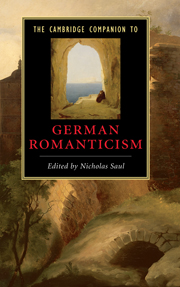Book contents
- Frontmatter
- 1 What is Romanticism, and where did it come from?
- 2 From early to late Romanticism
- 3 Prose fiction of the German Romantics
- 4 The Romantic lyric
- 5 The Romantic drama
- 6 Forms and objectives of Romantic criticism
- 7 Romanticism and Classicism
- 8 Women writers and Romanticism
- 9 The Romantics and other cultures
- 10 Love, death and Liebestod in German Romanticism
- 11 Romantic philosophy and religion
- 12 Romantic politics and society
- 13 Romantic science and psychology
- 14 German Romantic painters
- 15 Romanticism and music
- 16 Transformations of German Romanticism 1830-2000
- Key authors and their works
- Further reading
- Index
14 - German Romantic painters
Published online by Cambridge University Press: 28 September 2010
- Frontmatter
- 1 What is Romanticism, and where did it come from?
- 2 From early to late Romanticism
- 3 Prose fiction of the German Romantics
- 4 The Romantic lyric
- 5 The Romantic drama
- 6 Forms and objectives of Romantic criticism
- 7 Romanticism and Classicism
- 8 Women writers and Romanticism
- 9 The Romantics and other cultures
- 10 Love, death and Liebestod in German Romanticism
- 11 Romantic philosophy and religion
- 12 Romantic politics and society
- 13 Romantic science and psychology
- 14 German Romantic painters
- 15 Romanticism and music
- 16 Transformations of German Romanticism 1830-2000
- Key authors and their works
- Further reading
- Index
Summary
The work of German Romantic artists consistently reflects, directly or indirectly, the new aesthetic propagated by Romantic writers, critics and theorists. The two most significant painters of the epoch, Caspar David Friedrich and Philipp Otto Runge, were not given to issuing manifestos, preferring to set out their artistic agenda in letters to friends and relatives. Yet their paintings manifest the same tensions between empirical reality and spiritual vision which inform not only the poetic work of Romantic authors but also the theories of art enunciated by Romantics as diverse as Wackenroder and Friedrich Schlegel. Art was no longer conceived as a medium of entertainment, edification or even aesthetic gratification; rather, its function was to body forth insights into the transcendental. It was to be evaluated, not by the criterion of (good) taste, but according to its visionary intensity. In the HerzensergieBungen eines kunstliebenden Klosterbruders (1797; Heartfelt Outpourings of an Art-Loving Friar), which Wackenroder wrote with the assistance of Tieck, art is described as 'Hieroglypenschrift' ('hieroglyphic script'). The term was topical, since contemporary scholars were on their way to deciphering the Egyptian hieroglyphs. It implied a medium of communication which employed recognisable characters whilst remaining only partially comprehensible and thus offered tantalising but incomplete glimpses into ancient and arcane wisdom.
- Type
- Chapter
- Information
- The Cambridge Companion to German Romanticism , pp. 227 - 242Publisher: Cambridge University PressPrint publication year: 2009

